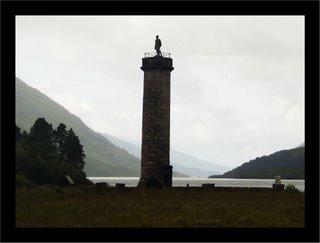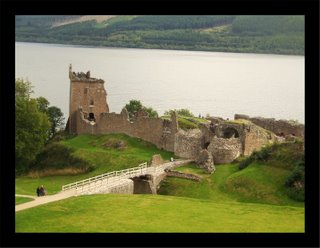Castles, Clans and Coldness - Part III

Sunday: I was so happy, because he arrived in time for us to spend a fantastic day seeing so many things I would never have gotten to see. Firstly, we went back to Glenfinnan to watch the “Harry Potter Steam Train” (ie. Jacobite Steam Train which has been doing the journey for over twenty years!). Glenfinnan also has the monument to the Jacobites:
Located 18½ miles (30 km) west of Fort William, at the head of Loch Shiel in Highland Council Area, the Glenfinnan Monument was erected in 1815 by Alexander Macdonald of Glenaladale as a tribute to the various clansmen who died fighting for the cause of Prince Charles Edward Stuart. Although the Prince's Standard was raised here in 1745, the campaign to reinstate the Stuarts to the throne of Great Britain met with defeat in 1746 on the battlefield at Culloden.Our second stop was the Commando Monument at Spean Bridge, which gives superb views across Fort William and over the Glen Nevis ranges (including Ben Nevis).
 This monument was placed at Spean Bridge because it was here that many commandos were trained near the headquarters at Achnacarry.
This monument was placed at Spean Bridge because it was here that many commandos were trained near the headquarters at Achnacarry. Our third stop was, of course, Loch Ness. After spending a little while staring at the large loch, waiting for movement, I decided that the Loch Ness Monster is simply a myth (try telling the thousands of tourists who pay mega dollars to visit the numerous Loch Ness Exhibitions along the way. Little did I realise, Loch Ness is actually an extremely large mass of water - not some kind of pond, as I first expected. No wonder no one can find the monster - its too big, and too deep.
We moved on to the third castle of my journey, Urquhart Castle, which overlooks Loch Ness. This castle has been ruined and rebuilt so much over time that they've lost track on who ruled it and who didnt. Which is why it is in ruins these days, rather than still in tact like Eileen Donan and others.

Anyhoo, was desperate to go to the toilet at that point, and once we found out that we had to pay 6 pounds just to get into the Information Centre to use their toilets, we quickly hurried back to the car and drove a further couple of miles to an Information Centre at Drummadrochit which didn’t charge such extortionate fees for toilet use.
Our fourth stop was Inverness. I wouldn’t say that Inverness is the most existing city on the planet, but it does house the fourth castle of the holiday, being Inverness Castle. Took the ceremonious photograph, ate lunch, then carried on.

Our fifth stop was the Boy’s choice of stop – it was the Cullodean Battlefield, where the last, and worst battle between the Highlanders and the British Government occurred. Basically, this signaled the end of the Scottish Clans, and to this day, the Scottish Nationalists signify this is the day they lost their homeland to “the other side” (ie. The English). The story alongside this battlefield was horrific – 1200 clansmen died at the hands of gun wielding soldiers. After the loss at Cullodean, tartan was banned in Scotland, as was the playing of the bagpipes (could they not have kept that ban in place?!?! hehehe). Going to a place of such national importance was special, going to it with a raging, passionate Scottish Nationalist was just plain insanity. I’m surprised he didn’t want me to stand there and re-enact part of it as a symbol of my utter devotion to the homeland (bless him!).

The rest of the afternoon was spent driving through the lovely Cairngorm Mountains, through Aviemore, Pitlochry and then back into Perthshire towards Edinburgh. I would have to say the area around Pitlochry is a favourite of mine, with its rolling hills, Scottish Castles and wooden bridges over flowing rivers.
Anyway, so by the end of the day, I was well and truly knackered, but so glad that the Boy had made the effort to drive three and a half hours up, to then drive another five hours, in order to show me his beautiful country. You don’t really begin to understand Scotland until you get up into the Highlands, learn how tough the environment and climate is, and still see the spirit of the Scots remain. Its where Scottish pride continues to exist.


0 Comments:
Post a Comment
Subscribe to Post Comments [Atom]
<< Home